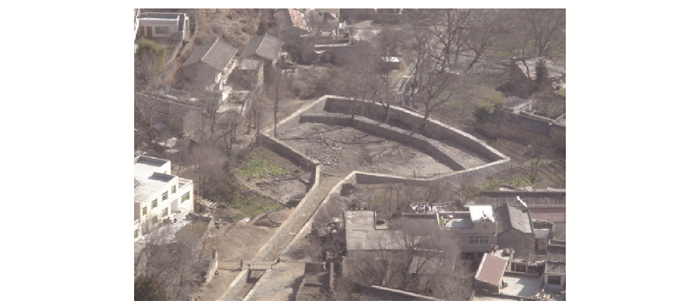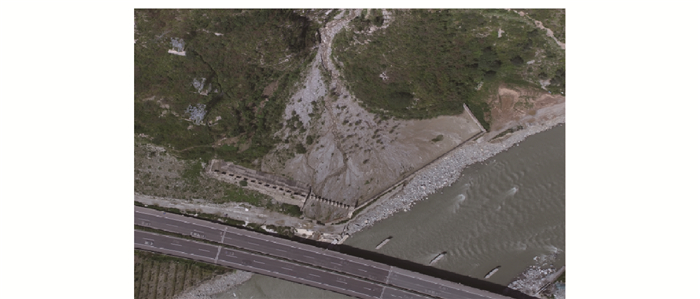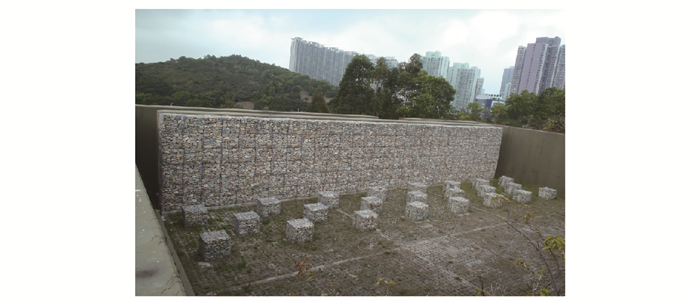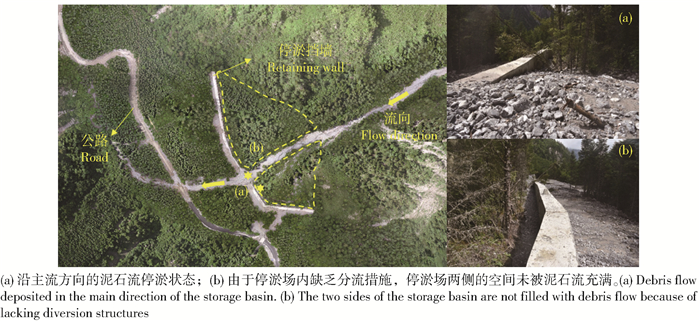2. 中国科学院大学, 100049, 北京;
3. 中国地质科学院探矿工艺研究所中国地质调查局地质灾害防治技术中心,611734,成都
中国水土保持科学  2024, Vol. 22 2024, Vol. 22  Issue (3): 12-19. DOI: 10.16843/j.sswc.2022001 Issue (3): 12-19. DOI: 10.16843/j.sswc.2022001 |
泥石流是我国山区常见的地质灾害类型之一,是一种介于滑坡和水流之间的含泥、沙和石块的固液两相流体[1],具有暴发突然、运动快速、破坏力强等特点,对于山区城(村)镇百姓的生产生活造成很大的影响。泥石流灾害严重制约社会经济发展。例如,2010年甘肃省舟曲县三眼峪和罗家峪发生特大泥石流,泥石流淤埋耕地、摧毁房屋建筑、堵塞河道形成堰塞湖,回水淹没大半个县城,造成重大人员伤亡和财产损失[2-3];2019年8月20日,受持续强降雨影响,四川省汶川县境内多处发生山洪泥石流灾害,造成多人遇难和失踪,都汶高速映秀段、国道213线等道路受损严重,交通中断[4]。随着社会经济的快速发展,泥石流灾害的制约作用尤为突出[5-7]。因此,通过工程防治可为处于危险区的基础设施和百姓的生产生活提供安全保障。
现有的泥石流防治体系由形成区的稳固工程、流通区的拦挡、排导和固床工程以及堆积区的排导、停淤工程组成。停淤工程作为其中一种类型在使用。停淤工程是根据泥石流运动和堆积机理,将泥石流引入预定地点让其自然减速、停淤或修建拦蓄工程迫使其停淤的一种设施,多数修建在沟道下游的堆积区,地形相对开阔、平缓的位置[8];但是随着工程治理中遇到的问题,诸如城镇空间、修建场地限制等原因,停淤场不得不修建在地形复杂、较陡的区域。汶川地震后就呈现出流域面积小、沟谷狭窄、沟床纵比降大的狭陡型泥石流沟道[9]。多条泥石流沟采用停淤措施,均达到良好的减灾效果[10-11];然而,在运行过程中,最突出的问题是停淤场内缺失分流、导流措施,导致停淤空间未合理利用,而且停淤工程仍以经验设计为主,未体现均衡停淤的理念。
笔者在查阅国内外相关文献资料的基础上,结合停淤工程的现场调查,发现在泥石流综合防治体系中,拦挡、排导工程都有深入的研究和相对成熟并且运用广泛的参数设计方法,而停淤工程到目前为止尚未有过系统性研究。笔者通过对野外泥石流停淤工程的调查,分析停淤工程的应用现状,并总结在设计和运行过程中存在的问题。基于以上分析,笔者提出泥石流停淤工程均衡停淤的理念,以及对泥石流停淤工程研究和设计的几点思考。
1 泥石流停淤工程应用现状笔者对四川省金川县蔡家沟、红桥沟泥石流停淤场和汶川地震区华溪沟、走马岭沟的停淤工程运行状况进行野外调查。四川省金川县红桥沟泥石流采用“拦挡+排导+停淤”的综合治理措施,停淤场位于金川县城建筑物密集区(图 1),可拦截一次设计标准的泥石流[12]。汶川地震区华溪沟采用以“拦挡+停淤”的治理措施,在沟口设置停淤工程(图 2),在泥石流主流线范围的停淤挡墙上设置开孔的格栅,可以使粗大颗粒拦截在停淤场内,细小颗粒进入岷江。与未设置防治工程措施相比,停淤工程的设置使泥石流主流线方向与岷江河道的方向斜交,避免泥石流堵塞河道;走马岭泥石流沟采用的停淤措施(图 3):一次冲出泥石流总量约153万m3,停淤场的库容约为25万m3,可以容纳一次冲出泥石流总量的1/6[13]。

|
图 1 金川县红桥沟 Fig. 1 Hongqiao gully, Jinchuan county |

|
图 2 汶川县华溪沟 Fig. 2 Huaxi gully, Wenchuan county |

|
图 3 绵竹市走马岭沟 Fig. 3 Zoumaling gully, Mianzhu city |
2017年“8 ·8”九寨沟地震后多条沟暴发泥石流,威胁遗产景观、景区道路、村寨以及旅游设施等。笔者对景区内分布的具有明显威胁的泥石流沟进行实地调查,结合景区已有的泥石流治理工程经验,考虑景区内泥石流沟的流域特征,采取以“拦挡和停淤”为主的防治工程措施[14]。我国香港地区Lantau Island为避免停淤场外的保护对象受泥石流影响,在停淤场内设置多排交错排列的障碍物来达到泥石流减速耗能快速停淤的目的[15](图 4)。

|
图 4 香港地区挡墙前设置的障碍物(宋东日 摄) Fig. 4 Baffles positioned in front of rigid barrier in Hong Kong (Provided by SONG Dongri) |
综合分析,停淤工程都发挥了重要的减灾作用。停淤工程的组成结构物主要有停淤挡墙、分流墙(堤)等[8],通过四周的停淤挡墙或挡墙与泥石流沟口两侧山体形成闭合空间用于停淤泥石流。分流墙(堤)引导泥石流均匀停淤。以上几类工程结构并不是单独使用,可以相互配合使用,但是在实际工程中,分流墙(堤)大多缺失,导致停淤场空间未能最大化利用。
2 泥石流停淤工程应用条件国内将停淤场划分为沟道停淤场、堆积扇停淤场、跨流域停淤场3种类型[8],堆积扇停淤场是应用最为广泛的一种类型,也是本研究重点讨论的停淤场类型。国外的停淤工程也基本布设于泥石流堆积区,奥地利等欧洲国家及美国等将停淤场称为storage basin,debris basin或stilling basin,日本将停淤工程称为debris flow deposition works,即在泥石流堆积扇上设计并用于接纳部分或全部泥石流物质的区域。表 1列出国内外在泥石流堆积区采取的防治工程类型,主要分为3类:1)挡墙结构(terminal wall,retaining wall),即通过挡墙结构阻止泥石流向前运动,迫使泥石流在到达保护对象前堆积;2)导流堤(deflection wall),即通过导流堤来改变泥石流的流向,保护威胁对象免受泥石流的危害;3)障碍物(debris flow barrier)即通过沙袋、土堆、柱、桩等结构达到减速耗能,快速堆积。
| 表 1 国内外泥石流堆积区设置的工程类型 Tab. 1 Engineering measures in debris flow deposition area in China and abroad |
我国泥石流停淤工程的应用主要集中于3方面:1)西部山区诸多城镇坐落于泥石流堆积扇,在完成城区建设的老城镇中,城市布局已确定,建筑物密集,无设置泥石流排导工程的空间条件;随着山区城镇化建设规模的不断扩大,城镇建设越靠近山脚,泥石流排导条件受限,须采取停淤工程的治理措施;还有部分沟道沟口比降较缓,不具备排导泥石流的纵坡条件,故停淤工程也成为主要的防治措施。例如,四川省金川县蔡家沟泥石流采用停淤工程(图 5a),停淤场就位于金川县城建筑物密集区[32];2)九寨沟风景名胜区内由于诸多泥石流沟不具备排导条件,并且沟道上游是国家级自然保护区规定的核心区,不能开展人类工程活动,很多条沟只能采取以“拦挡+停淤”的防治措施,但部分泥石流沟地形陡峭、沟床纵比降大,拦挡工程投资效益比低,并且景区公路紧邻沟口,故停淤工程成为景区内最主要的防治措施之一(图 5b);3)部分公路、铁路等线性工程从泥石流堆积扇穿越,排导措施无法更好地应用,只有在沟口与公路、铁路之间采用停淤措施(图 5c)。

|
图 5 泥石流停淤场 Fig. 5 Debris flow storage basin |
通过对上述停淤场的调查发现,停淤场在设计和运行过程中也存在一定的问题,主要表现在以下5方面:
1) 停淤场内缺乏泥石流分流、导流及均衡停淤措施。大部分泥石流沟道出山口呈非对称分布且停淤场内的地形起伏不平。由于泥石流直进性的特点,无法合理填充停淤空间,加之停淤场内缺乏泥石流分流、导流措施,导致停淤空间无法高效合理利用,未达到最佳停淤规模和均衡停淤的目的。例如,九寨沟卓追沟泥石流采用停淤工程措施,由于停淤场内缺乏人工干预措施,泥石流沿流向堆积在停淤场中部,两侧停淤空间未有效利用(图 6)。

|
图 6 九寨沟卓追沟泥石流停淤场 Fig. 6 Zhuozhui gully debris flow storage basin in Jiuzhaigou gully |
2) 停淤量计算以经验估算为主,计算结果与实际停淤量偏差大。通常的停淤量是停淤面积和停淤高度相乘的结果,实际的停淤场在平面上呈不规则形状,并且底部起伏不平,导致停淤高度不一致,并且未考虑泥石流性质等因素,故与实际停淤量偏差大。
3) 停淤场内缺乏快速堆积和减速耗能的措施。由于部分泥石流沟堆积区比降较大,泥石流流速快,直接冲击停淤挡墙,容易使沿主流方向的停淤挡墙损坏,或导致泥石流翻出挡墙,对挡墙外侧的保护对象产生危害。例如,金川县蔡家沟、红桥沟泥石流停淤场处于县城密集区,在停淤场内部各设置一道由块石堆砌的减速带,让泥石流耗能减速、快速停淤,避免泥石流翻越挡墙而危害保护对象(图 1和图 5a)。
4) 目前现行规范中停淤挡墙的设计未考虑泥石流冲击力。传统的泥石流停淤场面积大,泥石流流动至停淤挡墙前时,流速较小且快接近停淤状态。针对停淤场面积受限,并且停淤挡墙外侧布置有密集的城镇建筑或公路、铁路等线性工程,需要考虑泥石流对停淤挡墙的冲击力。
5) 堆积扇是人类赖以生存的重要场所,停淤场占堆积扇土地面积相对较大,而且人口的增长和城镇化的建设导致可利用土地愈发减少,形成泥石流防治工程与人类活动相互冲突的局面。
根据泥石流停淤工程存在的上述问题,笔者认为在设计中应考虑均衡停淤的理念,即以停淤场内泥石流均衡停淤为主线,防止泥石流在停淤场内出现不合理堆积,利用停淤场的地形条件,通过在停淤场内设置分流、导流结构,减小泥石流的能量,使其快速停淤;改变泥石流的流向,充分利用停淤空间,使停淤场发挥最大效益。停淤工程在考虑常规的设计原则下,应着重考虑以下内容:
1) 停淤场应有足够的净空,能够容纳1~2次设计标准下的停淤量或者多次小规模泥石流的停淤量;
2) 停淤场应设置合理的泥石流流动坡度,并考虑停淤场内人工调控措施,改变泥石流的堆积形态,使停淤场的空间最大化利用;
3) 为保证停淤挡墙的安全运行,应增设减速耗能结构,对传统的停淤结构进行优化;
4) 停淤挡墙的设计高度结合泥石流的性质、地形条件、设计库容等综合考虑,并考虑后续以增加高度来提高停淤库容;
5) 应充分考虑树木对泥石流运动和堆积的影响,发挥生态与岩土工程措施协同作用。
4 关于泥石流停淤工程的思考从目前已建泥石流停淤工程的应用现状分析,其工程设计仍处于经验状态。在泥石流停淤工程防治技术研究方面,缺乏系统性的研究工作,尤其是缺少定量化的计算方法,在以后的研究工作中可以从以下几方面深入开展(表 2)。
| 表 2 泥石流停淤工程研究的主要内容 Tab. 2 Main contents of studies on debris flow deposition engineering |
1) 停淤空间优化配置。停淤库容是停淤场最关键的设计参数之一,然而由于泥石流直进性的特点,泥石流并不会按照预期的设计停淤量进行停淤,使得停淤空间被浪费,导致实际停淤量与设计停淤量偏差较大,故需增加分流、导流和均衡停淤措施来达到合理停淤的目的。通过对停淤空间布局的优化,可以实现停淤场的最大化利用,尽量少的占用土地面积,留出更多的土地作为其他用途;并且可以降低停淤场清淤成本,若未进行停淤空间的优化,停淤场的有效空间就降低,需要多次清淤才能为后续的泥石流提供停淤空间,增加清淤成本。
2) 停淤挡墙结构优化。从目前的设计状况来看,停淤挡墙结构基本都采用相同的横断面结构尺寸,然而当泥石流冲击停淤挡墙后,对挡墙各位置处形成的冲击力和静土压力不同,尤其是泥石流正冲方向和两侧冲击力差异较大。因此,对停淤挡墙的结构型体进行优化是未来研究的重点。通过对停淤挡墙结构的优化,可降低施工成本,挡墙结构本身占地面积小,适合于风景区、村寨生态型泥石流的治理。
3) 停淤挡墙高度优化。停淤挡墙的高度取值是设计的关键参数之一,目前主要以经验取值为主,根据停淤方量来反算停淤挡墙的高度,忽视了泥石流性质、地形条件等因素影响。充分利用分流结构的减速耗能作用,可有效降低挡墙的高度。通过对停淤挡墙的优化,可降低施工成本,对环境干扰和影响较小,尤其适用于风景区、村寨生态型泥石流的治理。
泥石流停淤工程作为减灾效果良好的一类主体工程,但在实际应用中也存在很多问题,尤其是停淤工程的技术研究方面,还缺乏系统性的研究,作者正在开展该方面的研究工作。在以后的研究中,尤其在沟床比降大的条件下,需从物源区、流通区、堆积区考虑逐级调控,实现泥石流物质与能量的全过程调控,将泥石流停淤技术与拦挡、排导技术紧密结合,形成完整的泥石流综合防治技术,才能更好地服务于泥石流防灾减灾。
| [1] |
康志成, 李焯芬, 马蔼乃, 等. 中国泥石流研究[M]. 北京: 科学出版社, 2004: 2. KANG Zhicheng, LI Zhuofen, MA Ainai, et al. Debris flow research in China[M]. Beijing: Science Press, 2004: 2. |
| [2] |
TANG Chuan, RENGERS N, VAN ASCH T W J, et al. Triggering conditions and depositional characteristics of a disastrous debris flow event in Zhouqu city, Gansu province, northwestern China[J]. Nat. Hazards Earth Syst. Sci., 2011, 11(11): 2903. DOI:10.5194/nhess-11-2903-2011 |
| [3] |
胡凯衡, 葛永刚, 崔鹏, 等. 对甘肃舟曲特大泥石流灾害的初步认识[J]. 山地学报, 2010, 28(5): 628. HU Kaiheng, GE Yonggang, CUI Peng, et al. Preliminary analysis of extra-large-scale debris flow disaster in Zhouqu county of Gansu province[J]. Journal of Mountain Science, 2010, 28(5): 628. DOI:10.3969/j.issn.1008-2786.2010.05.017 |
| [4] |
靳文, 张国涛, 邹强, 等. 震后泥石流活跃期的新认识: 以四川汶川"8 ·20"灾害事件为例[J]. 山地学报, 2019, 37(5): 787. JIN Wen, ZHANG Guotao, ZOU Qiang, et al. A new understanding of the activity behavior of post-earthquake debris flow: Taking the "8 ·20" event in Wenchuan, Sichuan, China as an example[J]. Mountain Research, 2019, 37(5): 787. |
| [5] |
LIU Jinfeng, YOU Yong, CHEN Xiaoqing, et al. Characteristics and hazard prediction of large-scale debris flow of Xiaojia Gully in Yingxiu town, Sichuan province, China[J]. Engineering Geology, 2014, 180(2): 55. |
| [6] |
OUYANG Chaojun, WANG Zhongwen, AN Huicong, et al. An example of a hazard and risk assessment for debris flows: A case study of Niwan Gully, Wudu, China[J]. Engineering Geology, 2019, 263(4): 105351. |
| [7] |
HU Guisheng, TIAN Shufeng, CHEN Ningsheng, et al. An effectiveness evaluation method for debris flow control engineering for cascading hydropower stations along the Jinsha River, China[J]. Engineering Geology, 2020, 266(2): 105472. |
| [8] |
周必凡, 李德基, 罗德富, 等. 泥石流防治指南[M]. 北京: 科学出版社, 1991: 163. ZHOU Bifan, LI Deji, LUO Defu, et al. Guide to prevention of debris flow[M]. Beijing: Science Press, 1991: 163. |
| [9] |
杨东旭, 游勇, 陈晓清, 等. 汶川震区狭陡型泥石流典型特征与防治[J]. 水文地质工程地质, 2015, 42(1): 146. YANG Dongxu, YOU Yong, CHEN Xiaoqing, et al. Typical characteristics and mitigation of debris flow in narrow-steep gullies in the Wenchuan earthquake areas[J]. Hydrogeology & Engineering Geology, 2015, 42(1): 146. |
| [10] |
韩玫. 汶川地震"宽缓"与"窄陡"沟道型泥石流致灾机理研究[D]. 成都: 西南交通大学, 2016: 118. HAN Mei. Hazard mechanism research of wide-gentle and narrow-steep channels debris flow in Wenchuan earthquake region[D]. Chengdu: Southwest Jiaotong University, 2016: 118. |
| [11] |
胡涛. 汶川震区震后大型泥石流致灾机理及防治对策研究[D]. 成都: 成都理工大学, 2017: 129. HU Tao. The research on formation mechanism and mitigation measures of large-scale debris flow in the Wenchuan earthquake area[D]. Chengdu: Chengdu University of Technology, 2017: 129. |
| [12] |
游勇, 柳金峰, 谢洪, 等. 四川省金川县城区红桥沟、蔡家沟泥石流及其防治[J]. 中国地质灾害与防治学报, 2008, 19(4): 7. YOU Yong, LIU Jinfeng, XIE Hong, et al. The study on the debris flow and its controlling measures in Hongqiao and Caijia Gully in Jinchuan county of Sichuan province[J]. The Chinese Journal of Geological Hazard and Control, 2008, 19(4): 7. |
| [13] |
牟今容, 黄润秋, 裴向军. 四川绵竹走马岭沟特大泥石流成因及防治措施[J]. 人民长江, 2011, 42(19): 34. MOU Jinrong, HUANG Runqiu, PEI Xiangjun. Formation and prevention measures of catastrophic debris flow in Zoumaling valley in Mianzhu city, Sichuan province[J]. Yangtze River, 2011, 42(19): 34. |
| [14] |
ZHAO Wanyu, YOU Yong, CHEN Xiaoqing, et al. Case study on debris-flow hazard mitigation at a world natural heritage site, Jiuzhaigou Valley, western China[J]. Geomatics, Natural Hazards and Risk, 2020, 11(1): 1782. DOI:10.1080/19475705.2020.1810784 |
| [15] |
CHOI C E, NG C W W, SONG Dongri, et al. Flume investigation of landslide debris-resisting baffles[J]. Can. Geotech. J., 2014, 51(5): 540. DOI:10.1139/cgj-2013-0115 |
| [16] |
MARCHI L, COMITIB F, CREMA S, et al. Channel control works and sediment connectivity in the European Alps[J]. Science of the Total Environment, 2019, 668: 389. |
| [17] |
VANDINE D F. Debris flow control structures for forest engineering[M]. Victoria: B.C. Min. For., 1996: 27.
|
| [18] |
HUBL J, SUDA J. Debris flow mitigation measures in Austria[C]. Debris Flows: Disasters, Risk, Forecast, Protection. Pyatigorsk: Sevkavgiprovodkhoz Institute, 2008: 27.
|
| [19] |
COSENZA E, COZZOLINO L, PIANESE D, et al. Concrete structures for mitigation of debris-flow hazard in the Montoro Inferiore Area, southern Italy[C]. Proceeding of 2nd International Congress, Naples, Italy, 2006: 1.
|
| [20] |
WEINMEISTER H W. Integrated debris flow disaster mitigation: A comprehensive method for debris flow disaster mitigation[J]. Journal of Mountain Science, 2007, 4(4): 293. |
| [21] |
REMAITRE A, MALET J P. The effectiveness of torrent check dams to control channel instability: Example of debris-flow events in clay shales[C]. Garcia C C, Lenzi M A, Check dams, morphological adjustments and erosion control in torrential streams. Nova Science Publishers, 2010: 211.
|
| [22] |
GENEVOIS R, TECCA P R, DEGANUTTI A M. Debris flow mitigation and control in the dolomites (north-eastern Italy)[J]. Italian Journal of Engineering Geology and Environment, 2018(2): 57. |
| [23] |
JAKOB M, HUNGR O. Debris-flow hazards and related phenomena[M]. Berlin: Springer-Verlag, 2005: 447.
|
| [24] |
PROCHASKA A B, SANTI P M, HIGGINS J D. Debris basin and deflection berm design for fire-related debris-flow mitigation[J]. Environmental & Engineering Geoscience, 2008, 14(4): 297. |
| [25] |
MANCARELLA D, HUNGR O. Analysis of run-up of granular avalanches against steep, adverse slopes and protective barriers[J]. Canadian Geotechnical Journal, 2010, 47(8): 827. |
| [26] |
IKEYA H. Debris flow and its countermeasures in Japan[J]. Bulletin of the International Association of Engineering Geology, 1989, 40(1): 15. |
| [27] |
TAKAHASHI M. Debris flow mechanics, prediction and countermeasures[M]. London: Taylor & Francis, 2007: 337.
|
| [28] |
CHOI S K, PARK J Y, LEE D H, et al. Assessment of barrier location effect on debris flow based on smoothed particle hydrodynamics (SPH) simulation on 3D terrains[J]. Landslides, 2021, 18(1): 217. |
| [29] |
OKUBO S, IKETA H, ISHIKAWA Y, et al. Development of new methods for countermeasures against debris flows[C]. In: Armanini A., Michiue M. (eds) Recent Developments on Debris Flows. Lecture Notes in Earth Sciences, Springer, Berlin, Heidelberg, 1997.
|
| [30] |
MIZUYAMA T. Structural countermeasures for debris flow disasters[J]. International Journal of Erosion Control Engineering, 2008, 1(2): 37. |
| [31] |
程尊兰, 吴积善, 张家福, 等. 西部山区河滩地开发与保护规划研究[M]. 北京: 科学出版社, 2002: 184. CHENG Zunlan, WU Jishan, ZHANG Jiafu, et al. Study on development and protection planning of flood land in western mountainous area[M]. Beijing: Science Press, 2002: 184. |
| [32] |
LIU Jinfeng, NAKATANI K, MIZUYAMA T. Effect assessment of debris flow mitigation works based on numerical simulation by using Kanako 2D[J]. Landslides, 2013, 10(2): 161. |
| [33] |
CHEN Xiaoqing, CUI Peng, YOU Yong, et al. Engineering measures for debris flow hazard mitigation in the Wenchuan earthquake area[J]. Engineering Geology, 2015, 194: 73. |